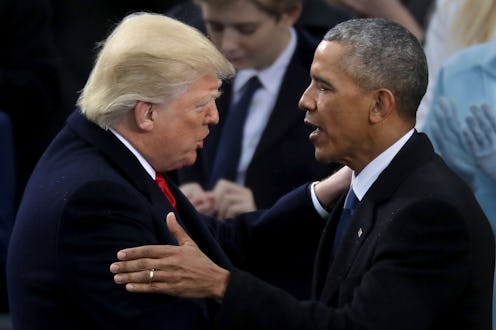
In the upcoming days, several of President Trump's federal court nominees will face confirmation votes in the U.S. Senate. These nominees represent just some of the many people Trump has selected to serve as judges in various courts across the country — and he's been getting them confirmed at a breakneck pace. As the president continues to move forward with an ambitious judicial nomination plan, looking at Trump's judicial nominees versus Obama's lends insight into how the nomination and confirmation process has changed under the 45th president.
As HuffPost reported on March 4, so far Trump has nominated — and received confirmation for — over 30 circuit judges, more than 50 district judges, and two Supreme Court justices in just over two years in office. Comparatively, during his eight-year tenure, Obama nominated and confirmed 55 circuit judges, 268 district court judges, and two Supreme Court justices.
Trump could be on track to outpace Obama with his circuit court confirmations, as he had already reached over half of Obama's total confirmations in eight years in just over two years. Trump's circuit court nominations have been so prolific that, currently, one in six seats on U.S. circuit courts is filled by a judge who was nominated by Trump, HuffPost reported.
Beyond Trump's high rate of nominations and confirmations compared to Obama, his judicial nominees have so far been less diverse than those of the 44th president. As Vox reported in December, 76 percent of the Trump's judicial nominees who had been confirmed at that time were men. NPR also reported in November 2018 that 82 percent of Trump's nominees were white. Comparatively, Vox noted that 41 percent of federal judges confirmed under Obama were women — and NPR added that 63 percent of judges nominated under Obama were white. Vox and HuffPost also reported that Trump's nominees have tended to be slightly younger than Obama's.
In addition to their demographic characteristics, Trump's and Obama's nominees have some other key differences. Some of Trump's nominees were confirmed during recess appointments, or those conducted while the Senate was not in session. As NPR reported, prior to the Trump administration, the Senate had never confirmed judicial nominees during a Senate recess.
Moreover, some of Trump's nominees, unlike Obama's, have also circumvented a traditional home state senator approval process. As the Washington Post reported, traditionally, senators from a judicial nominee's home state are allowed to provide opinions (called blue slips) on nominees or to choose to not return these slips, which is interpreted as a lack of support. As the New York Times reported, Obama never had a nominee confirmed if a home state senator failed to return a blue slip or returned a blue slip with a negative opinion.
However, Trump has already thwarted this traditional Senate process with one of his nominees. In fact, as the Washington Post reported on Feb. 28, Trump nominee Eric Miller was appointed to the Ninth Circuit Court of Appeals, even though neither senator from his home state of Washington submitted a blue slip on his behalf. This is the first time since at least 1979 that the Senate confirmed a judicial nominee who had two unreturned home state blue slips, the paper reported.
Overall, Trump seems to be nominating federal court judges — particularly those at the circuit court level — at a faster pace than Obama, and is getting judges confirmed in unprecedented ways. As the remainder of Trump's term unfolds, you might want to keep tabs on just how many total judicial confirmations he is able to secure compared to Obama and other previous presidents.